By Jackie Damrau, Editor
Books Reviewed in This Issue
The reviews provided here are those that are self-selected by the reviewers from a provided list of available titles over a specific date range. Want to become a book reviewer? Contact Dr. Jackie Damrau at jdamrau3@gmail.com for more information.
Head First Git: A Learner’s Guide to Understanding Git from the Inside Out
Raju Gandhi
The Stylistics of ‘You’: Second-Person Pronoun and Its Pragmatic Effects
Sandrine Sorlin
Principles of Web Design
Brian D. Miller
Human-Centered Leadership in Healthcare: Evolution of a Revolution
Kay Kennedy, Lucy Leclerc, and Susan Campis
Motivational Immediacy: Fostering Engagement in Adult Learners
Jonathan E. Taylor
A Student’s Introduction to English Grammar, 2nd ed
Rodney Huddleston, Geoffrey K. Pullum, and Brett Reynolds
The Cambridge Guide to Reading Poetry
Andrew Hodgson
Type Specimens: A Visual History of Typesetting and Printing
Dori Griffin
Social Engineering: How Crowdmasters, Phreaks, Hackers, and Trolls Created a New Form of Manipulative Communication
Robert W. Gehl and Sean T Lawson
How to Take Over the World: Practical Schemes and Scientific Solutions for the Aspiring Supervillain
Ryan North
Embodied Environmental Risk in Technical Communication: Problems and Solutions Toward Social Sustainability
Samuel Stinson and Mary Le Rouge, eds.
Save Me! (From Myself): The Existential Crises of a Creative Introvert
So Lazo
The Secret Language of Maps: How to Tell Visual Stories with Data
Carissa Carter
25 Great Sentences and How They Got That Way
Geraldine Woods
Our Plastic Problem and How to Solve It
Sarah J. Morath
The Insider’s Guide To Technical Writing, 2nd ed.
Krista Van Laan
Academia Next: The Future of Higher Education
Bryan Alexander
Rebel with a Clause: Tales and Tips from a Roving Grammarian
Ellen Jovin
Leading with Values: Strategies for Making Ethical Decisions in Business and Life
Neil Malhotra and Ken Shotts
Balance: How It Works and What It Means
Paul Thagard
Fragile Futures: The Uncertain Economics of Disasters, Pandemics, and Climate Change
Vito Tanzi
Head First Git: A Learner’s Guide to Understanding Git from the Inside Out
Raju Gandhi. 2022. O’Reilly Media, Inc. [ISBN 978-1-492-09251-3. 470 pages, including index. US$69.99 (softcover).]
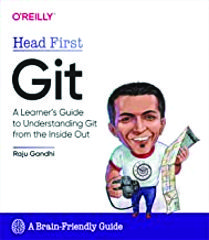 New technology often comes with its own set of buzzwords and lingo. If you are reading about technology or talking with software developers, there is a strong chance that you have already heard of Git, without ever hearing how to use it, or what it is used for. Many books are written as references answering questions such as, “How do you create a table of contents in MS Word?” You pick up the book, learn to do the one task, and then put the book down, possibly forgetting all the rest of the knowledge you may have picked up. Books like that are not meant to be read straight through. However, Head First Git: A Learner’s Guide to Understanding Git from the Inside Out is not a simple reference guide; it is an all-inclusive workshop that is set up to teach you how to use Git.
New technology often comes with its own set of buzzwords and lingo. If you are reading about technology or talking with software developers, there is a strong chance that you have already heard of Git, without ever hearing how to use it, or what it is used for. Many books are written as references answering questions such as, “How do you create a table of contents in MS Word?” You pick up the book, learn to do the one task, and then put the book down, possibly forgetting all the rest of the knowledge you may have picked up. Books like that are not meant to be read straight through. However, Head First Git: A Learner’s Guide to Understanding Git from the Inside Out is not a simple reference guide; it is an all-inclusive workshop that is set up to teach you how to use Git.
First, Git is a free source control system commonly used to track and store files used when creating computer code. It creates a primary repository where you store files and track changes to them as you work on your code. It need not be solely computer code, as it can also be HTML, XML, and other text-based documentation. You can create a free account on GitHub to store your files in the cloud where you can even solicit feedback from others.
Next, Head First Git stands out above other reference guides in that it is really an easy-to-follow class for Git. It teaches all the basics, along with sophisticated concepts, and gradually builds up your confidence and knowledge through interactive exercises and activities. A website resource provides downloadable files that match each chapter of the book. Once you have these files, they sync up with each exercise, enabling you to experience firsthand how Git works with files, and so you do not have to create each exercise’s content from scratch. The language is light, but serious, and strives to make sure that the reader is not just following along with the concepts but implementing them as well. Git is command line based, like LINUX, so using Git may have more of a learning curve than other source control systems. However, Head First Git strives to demystify the complexities of the application and build on prior knowledge learned.
If you are interested in learning a tool that is widely used across the world, and would like to gain a firm understanding of source control systems for whatever files you are using, then pick up a copy of Head First Git. Grab a pencil, warm up your computer, and get ready to learn. This book is designed to be worked through interactively, not passively read from your recliner. While it can be used just for reference, Head First Git is designed to be your instructor in the world of Git. You’ll want to “git add” it to your collection, and then “git commit” it to your home repository/bookshelf. Then, don’t be afraid to “git push” it on your friends.
Timothy Esposito
Timothy Esposito is the Manager of Logistics Documentation at Oracle, an STC Fellow, the STC Vice President, and a past president of the STC Philadelphia Metro chapter with more than 20 years of technical communication experience.
The Stylistics of ‘You’: Second-Person Pronoun and Its Pragmatic Effects
Sandrine Sorlin. 2022. Cambridge University Press. [ISBN 978-1-108-83302-8. 254 pages, including index. US$110 (hardcover).]
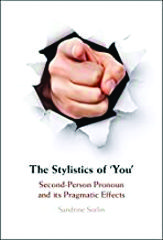 Linguist Sandrine Sorlin astonished a colleague by announcing that she was writing an entire book on the second person pronoun. I, too, am surprised by the many ways she has parsed the second person point of view in The Stylistics of ‘You’: Second-Person Pronoun and Its Pragmatic Effects. Sorlin theorizes that the second person can be conveyed in text without necessarily using the word “you,” yet the reader feels addressed by the writer. “The book explores how the reader imaginatively ‘simulates’ the narrator’s thoughts and experience” (p. 230) without that specific pronoun. The exploration takes her readers “across genre, time and medium” (p. ix). Examples include fiction as well as nonfiction, 18th- to 21st-century writings, and print as well as digital texts.
Linguist Sandrine Sorlin astonished a colleague by announcing that she was writing an entire book on the second person pronoun. I, too, am surprised by the many ways she has parsed the second person point of view in The Stylistics of ‘You’: Second-Person Pronoun and Its Pragmatic Effects. Sorlin theorizes that the second person can be conveyed in text without necessarily using the word “you,” yet the reader feels addressed by the writer. “The book explores how the reader imaginatively ‘simulates’ the narrator’s thoughts and experience” (p. 230) without that specific pronoun. The exploration takes her readers “across genre, time and medium” (p. ix). Examples include fiction as well as nonfiction, 18th- to 21st-century writings, and print as well as digital texts.
The case studies in The Stylistics of ‘You’ exist along a continuum diagrammed by Sorlin in an early chapter, and to which she refers throughout the book. The author begins by setting out the “dynamic constellation” (p. 233) of ways the second person can be expressed in text that allows the reader to identify with the writer. She hypothesizes that there are six ways to convey “you.” Is the audience directly addressed as “you” in an ad campaign? Does the reader identify with the “first-person narrator hiding behind the second person” in a writer’s journal (p. 58)? Is the reader of digital fiction addressed by a voice-over protagonist? Each of these possibilities falls within the continuum of “you” that runs from the first person (I or one) engaging the reader as the second person (You1) to a voice-over narrator speaking about and to a reader (You6). Examples illustrating one or more of the “you” numbers are analyzed in detail in each chapter. The author ends with an analysis of Kevin Spacey’s YouTube video in which he uses the second person as a tool to manipulate his audience.
Besides demonstrating the possible versions of the second person, Sorlin’s goal is to “help the reader better grasp the diversity of … effects the word can produce” (p. ix). By analyzing how the language brings the reader into the author’s world, she maintains she is also gaining a perspective on the kind of empathy the language may engender. Her belief is that she is making a connection between linguistics and ethics that is not usually achieved.
Although The Stylistics of ‘You’ has its lighter moments, it is a dense text intended for an audience familiar with linguistic terminology. It requires careful reading, especially for anyone who does not know this vocabulary. Because it is surprising how the second person may be wrapped up in many guises, and because Sorlin has presented concepts a writer may find helpful in thinking about their relationship with their audience, it is a book that may well be worth diving into.
Linda M. Davis
Linda M. Davis is an independent communications practitioner in the Los Angeles area. She holds an MA in Communication Management and has specialized in strategic communication planning, publication management, writing, and editing for more than 25 years.
Principles of Web Design
Brian D. Miller. 2022. Allworth Press. [ISBN 978-1-62153-787-8. 268 pages, including index. US$35.00 (softcover).]
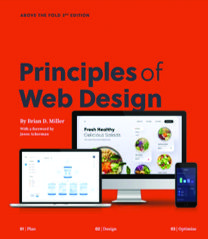 People have been browsing websites for over two decades, so it may seem elementary to require instruction on creating a quality website. However, once someone comes across a poorly designed site, not everyone is equipped to create usable, attractive web content. Principles of Web Design strives to guide the budding web developer on a path to success. While most web developers may want to just jump in and begin creating content, Brian D. Miller puts forth a three-level process for web design: Plan, Design, and Optimize.
People have been browsing websites for over two decades, so it may seem elementary to require instruction on creating a quality website. However, once someone comes across a poorly designed site, not everyone is equipped to create usable, attractive web content. Principles of Web Design strives to guide the budding web developer on a path to success. While most web developers may want to just jump in and begin creating content, Brian D. Miller puts forth a three-level process for web design: Plan, Design, and Optimize.
Before any successful project can begin, a plan must be created. A site design should be mocked up, showing both the physical structure to the site’s files, and a flow for intended users. Drill into details, like custom error messages to fit with your site’s branding. Configure the visual layout of the site, including use of white space, fonts, and styles. Consider how it will look on a mobile device or tablet. Once you have these basics in place, you can begin to create the site itself. However, before you start adding content, you should consider site concepts such as menu navigation, headers and footer, and content that appears at the top of the page before you scroll. There are dozens of concepts to consider, ranging from colors to image animation. Finally, once the site is largely prepared, move into optimizing it. Design your content so it can be easily found by search engines, which is known as Search Engine Optimization (SEO). Set up tools to track who is using your site, and which pages get the most attention. Consider implementing an email campaign that ties into your website to increase visits to your site.
Throughout Principles of Web Design, Miller lays out each concept in a logical order and illustrates them all using sample websites. Even if you have never heard of SEO before, Miller provides a worthy overview, more than enough to get you started. While he may not tell you the exact colors or fonts to use on a site, Miller does give broad examples of what to look for when choosing such elements. Illustration is one area where he falls a little short. While the book is lavishly illustrated with screen captures from websites, flow diagrams, grids, and colors, sometimes the illustrations appear too small on the page for any detailed scrutiny, perhaps obscuring the point of the image. Despite that one shortcoming, Principles of Web Design is a fine book to get you started on creating your own website masterpiece, laying it out, and getting visitors to eagerly return for information.
Timothy Esposito
Timothy Esposito is the Manager of Logistics Documentation at Oracle, an STC Fellow, the STC Vice President, and a past president of the STC Philadelphia Metro chapter with more than 20 years of technical communication experience.
Human-Centered Leadership in Healthcare: Evolution of a Revolution
Kay Kennedy, Lucy Leclerc, and Susan Campis. 2022. Morgan James Publishing. [ISBN 978-1-63195-553-2. 236 pages. US$18.95 (softcover).]
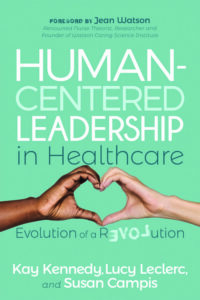 Nurses in a 21st century workforce encounter new and unique problems daily: complex technology, new medicines and treatments, and a constant pressure to meet higher standards with ever shrinking resources. Conquering these issues requires effective modern nursing leadership that meets a wider variety of needs than a traditional top-down style. Nurses Kay Kennedy, Lucy Leclerc, and Susan Campis assert that their new model of nursing leadership—the human-centered model—is up to the challenge.
Nurses in a 21st century workforce encounter new and unique problems daily: complex technology, new medicines and treatments, and a constant pressure to meet higher standards with ever shrinking resources. Conquering these issues requires effective modern nursing leadership that meets a wider variety of needs than a traditional top-down style. Nurses Kay Kennedy, Lucy Leclerc, and Susan Campis assert that their new model of nursing leadership—the human-centered model—is up to the challenge.
“Human-Centered Leadership in Healthcare embodies the principles of complexity science. It [is] different from traditional leadership in that the leader is embedded in the system. The influencers and innovators are those at the point of care” (p. 1). These three authors provide evidence for their leadership theory with a compelling Institutional Review Board-approved clinical study that yielded qualitative results. Results included anecdotes and narratives, along with literature studies and historical perspectives. Although they provide the reader with a citation to investigate the research study further, the authors’ study summary is somewhat limited. Improvements could include details that would make their conclusions more lucid; for example, the exact length of the study is omitted as well as details about the content of the focus groups. It is mentioned that they categorized the responses into a matrix and “coded” them, but this process is not explained thoroughly. Their arguments would be more compelling if more of the results were directly linked to the conclusions of their leadership model.
From this research study, the authors formulated their theory of leadership based on the idea that self-care, self-awareness, mindfulness, and emotional intelligence are all springboards upon which a leader embeds themself within a healthcare system. “Human-Centered Leaders require intentional development of skills that support the leader’s effectiveness and the ability to create a sustainable culture of Excellence, Trust and Caring” (p. 131). The authors’ outline the attributes of excellence as embodied by the Awakener: a motivator, coach, mentor, architect, and advocate (p. 131). They then list the characteristics of trust embodied by the Connector: collaborator, supporter, edge walker, engineer, and authentic communicator (p. 98). Concluding their leadership model by listing the components of caring embodied by the Upholder: mindful, others-oriented, emotionally aware, socially and organizationally aware, and personally well and healthy (p. 115). The authors’ primary argument is that a truly effective leader in nursing must have all these skills, as well as the ability to discern when it is appropriate to emphasize one over another.
Overall, Human-Centered Leadership in Healthcare: Evolution of a Revolution is an excellent resource for nurses. However, the terms and language used assume the reader has experience in both healthcare and leadership. Including a quick-reference glossary with leadership terms and nursing acronyms would be helpful for someone new to both fields. Many skills described like reflective journaling, mindfulness, and appreciative inquiry are useful in developing leaders in other service professions aside from nursing. With this leadership model, Kennedy, Leclerc, and Campis have opened the door to their “evolution of a revolution.”
Julie Kinyoun
Julie Kinyoun is an on-call chemistry instructor at various community colleges in Southern California. An avid reader, she enjoys reviewing books that help her become a better educator.
Motivational Immediacy: Fostering Engagement in Adult Learners
Jonathan E. Taylor. 2022. Stylus Publishing. [ISBN 978-1-62036-955-5. 190 pages, including index. US$35.00 (softcover).]
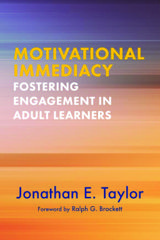 As an instructor, if you’ve encountered students with bland smiles and glazed eyes, you can assume they’re not keenly interested in what you’re teaching now. Well, this book may be for you. In Motivational Immediacy: Fostering Engagement in Adult Learners, Jonathan E. Taylor brings his experience in corporate training and higher education to the issue of learner motivation and engagement.
As an instructor, if you’ve encountered students with bland smiles and glazed eyes, you can assume they’re not keenly interested in what you’re teaching now. Well, this book may be for you. In Motivational Immediacy: Fostering Engagement in Adult Learners, Jonathan E. Taylor brings his experience in corporate training and higher education to the issue of learner motivation and engagement.
The author begins with the premise that all learners are motivated—either to learn or to avoid learning. This leads to the concept of learner resistance, a lack of engagement or openness to learning. Taylor distinguishes global (long-term) motivation to achieve goals like getting a degree or promotion from immediate motivation that keeps learners engaged at any given time. Motivational immediacy, he argues, is necessary for learning success, as “human learning is a moment-by-moment dynamic” (p. 46).
Educators need to keep a finger on the pulse of individual learners and try to connect students’ lives to course content. Taylor stresses that learner resistance and affective aspects “need to be seen as the driving force of all learning….[T]eaching is more than getting someone to know something; it is getting someone to accept something” (p. 101). Consistent with his learner-centered approach, Taylor outlines a seven-step teaching model (Chapter 6), offers “four heretical rules for curriculum” (Chapter 7), and presents five rules of teaching (Chapters 1, 4, 8, and 9), which he applies to online and face-to face learning spaces.
The subtitle, Fostering Engagement in Adult Learners, might lead readers to believe this is a how-to book, but despite several examples, the balance tips in favor of theory. Taylor says, “[t]o employ practical methods in our classrooms effectively, we first must grasp the conceptual principles in which they are rooted.” Fair warning because his extensive literature review reads somewhat like a doctoral dissertation. The author himself refers to the book as “a long and winding journey” that attempts to “travel all the way through the ideas to a point where the reader can see some practical way forward” (p. 158).
While practical nuggets provide an enjoyable counterbalance to theory, those who seek a book about fostering engagement would likely appreciate even more in the way of application and have the acumen to adapt examples to their own teaching situation.
Taylor’s writing style is friendly and at times impassioned, as in his rant against designing curriculum around the ability to assess learning objectives: “[T]his bit of nonsense has sucked much of the soul out of the learning that issues from it…Measure what you can, teach what you must” (p. 161). At this point, teachers in the reading audience no doubt jump to their feet and cry, “Hear! Hear!”
Teachers and trainers who wonder why well-planned lessons fall flat at times as well as anyone who wants a solid theoretical base in learner motivation and engagement will find valuable takeaways in Motivational Immediacy: Fostering Engagement in Adult Learners.
Bonnie Denmark
Bonnie Denmark is an STC Member and coordinates the Business/Technical Writing Option at Western Connecticut State University. She teaches undergraduate courses and mentors graduate students in their technical communication interest. Bonnie was previously a software developer and technical communicator, focusing on natural language applications, human interface, testing protocols, and health/science writing.
A Student’s Introduction to English Grammar
Rodney Huddleston, Geoffrey K. Pullum, and Brett Reynolds. 2002. 2nd ed. Cambridge University Press. [ISBN 978-1-00-908801-5. 400 pages, including index. US$34.99 (softcover).]
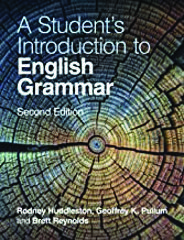 A Student’s Introduction to English Grammar is a new edition of Rodney Huddleston and Geoffrey Pullum’s award-winning 2002 edition, The Cambridge Grammar of the English Language. In this second edition, the authors (including Brett Reynolds) explain why older authorities are mistaken in what they deemed to be “incorrect” grammar. Readers (primarily students at colleges and universities, but anyone who wants to get up to speed on modern English grammar) will find that this textbook is written in a conversational, easy-to-read style.
A Student’s Introduction to English Grammar is a new edition of Rodney Huddleston and Geoffrey Pullum’s award-winning 2002 edition, The Cambridge Grammar of the English Language. In this second edition, the authors (including Brett Reynolds) explain why older authorities are mistaken in what they deemed to be “incorrect” grammar. Readers (primarily students at colleges and universities, but anyone who wants to get up to speed on modern English grammar) will find that this textbook is written in a conversational, easy-to-read style.
From the authors’ perspective, principles of English grammar “have to be discovered through research, theory formation, and testing.” However, advice on English grammar tends to “repeat useless definitions formulated hundreds of years ago and propose baseless prohibitions and restrictions” (p. xi). A Student’s Introduction to English Grammar presents an analysis of English grammar that accounts for newer discoveries in linguistic research.
Chapter 1 addresses general issues relating to written and spoken English, formal and informal style, and the structure of sentences. Chapter 2 provides a survey of the entire book and introduces concepts like word forms and lexemes, phrases and clauses, adjectives and adverbs, prepositions, adjuncts, and various constructions. The book’s detailed content is in the remaining 14 chapters, including end-of-chapter exercises. Huddleston, Pullum, and Reynolds do not attempt to cover historical change, sociolinguistic variation, or the structure of non-standard dialects.
Each chapter thoroughly describes the concepts and provides extensive examples that are not repeated in the end-of-chapter exercises. Interestingly, or maybe frustratingly, an exercise answer key is not provided; the intention appears to be that instructors provide answers to students in the classroom.
To quote a review from the back cover of A Student’s Introduction to English Grammar, Bryan Garner, Chief Editor at Black’s Law Dictionary, said “Don’t try to read it in one weekend. Pace yourself and read it, say, over the course of two months. Soon you’ll be regaling your friends with accounts of subject extraposition, pseudo-clefts and bare existentials. If you’re not the life of the party, then you’re attending the wrong parties.” It’s good advice; pace yourself. And whether you intend to store all that knowledge in your brain or share it at parties, you will be well-versed in modern sentence structure in the English language.
Michelle Gardner
Michelle Gardner is a contracted senior writer at Microsoft focused on their cloud portfolio. She has a bachelor’s degree in Journalism: Public Relations from California State University, Long Beach, and a master’s degree in Computer Resources and Information Management from Webster University.
The Cambridge Guide to Reading Poetry
Andrew Hodgson. 2022. Cambridge University Press. [ISBN 978-1-108-82412-5. 256 pages. US$19.99 (softcover).]
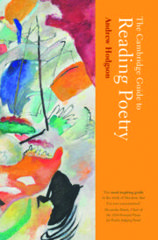 In The Cambridge Guide to Reading Poetry, Andrew Hodgson provides an illuminating guide for how to read and engage with poetry closely and intensely, using many examples from diverse eras and geographical areas of poetry written in English to illustrate his arguments. The book is not a simple how-to guide—rather, what Hodgson presents here is a comprehensive way of understanding poetry through the perspective of a knowledgeable, articulate guide. The author argues that “Poetry pays and communicates precise attention to experience, and part of the value of reading poems is that it trains us to pay similarly precise attention” (p. 48). Throughout, he achieves this “precise attention to experience” to the reading of poetry that he argues is one of poetry’s defining features.
In The Cambridge Guide to Reading Poetry, Andrew Hodgson provides an illuminating guide for how to read and engage with poetry closely and intensely, using many examples from diverse eras and geographical areas of poetry written in English to illustrate his arguments. The book is not a simple how-to guide—rather, what Hodgson presents here is a comprehensive way of understanding poetry through the perspective of a knowledgeable, articulate guide. The author argues that “Poetry pays and communicates precise attention to experience, and part of the value of reading poems is that it trains us to pay similarly precise attention” (p. 48). Throughout, he achieves this “precise attention to experience” to the reading of poetry that he argues is one of poetry’s defining features.
This book has three main sections. The first, “Reading a Poem,” is the central part of the text at 190 pages. This section is broken up into subsections of questions, such as “What Is the Poem about?,” “How Do the Lines Move?,” “Does the Poem Rhyme?,” and “Who Is Speaking?” These questions are misleadingly simple. Through them, Hodgson illuminates how different poets use these features of poetry in their craft to divergent effects, leading the reader to an in-depth way of understanding these elemental concerns of poetry from myriad styles of poetry. The second section, “Studying a Poet,” shows the reader how to delve deeply into the oeuvre of a poet through reading their poems, biographies, and criticisms about them. To illustrate this, Hodgson uses an older poet, Emily Bronte, and a contemporary poet, Srinivas Rayaprol, to show the different factors involved in research depending on how much information about the poet is available. The third section, “Writing about Poetry,” provides a guide most useful to undergraduate students for how to write close-reading and argumentative seminar papers using the skills and insights gained from the first two sections.
Hodgson intends this guide “for students from high school upward and for the general reader,” though the immense detail in each subsection of the first part will likely prevent all but the most serious of high-school and general readers from delving into and completing this book (p. 1). The book’s language is accessible, lucid, and direct, rarely dipping into undefined poetic jargon. As such, The Cambridge Guide to Reading Poetry would be useful for technical communicators looking to reintroduce themselves to the act of reading poetry critically, or even those looking for a way to write a guide for difficult and diffuse subjects with clarity.
Dylan Schrader
Dylan Schrader is a proposal developer at the University of Alabama in Huntsville, where he also earned MAs in English and Professional Communication.
Type Specimens: A Visual History of Typesetting and Printing
Dori Griffin. 2022. Bloomsbury Visual Arts. [ISBN 978-1-350116-59-7. 256 pages. US$34.95 (softcover).]
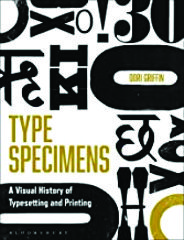 For a while now, design educators and historians have been calling for a broadening of the design canon, and for investigations into design history that create room for a more diverse expression of that history. While there is no one solution to this problem, Dori Griffin’s new book, Type Specimens: A Visual History of Typesetting and Printing, is a great example of how this can be done. The introduction lays out the goals of for the reader, including expanding access to design history and designed artifacts, providing historical context around artifacts, diverse global references and resources, and to present as many images as possible to serve as references for visual thinkers.
For a while now, design educators and historians have been calling for a broadening of the design canon, and for investigations into design history that create room for a more diverse expression of that history. While there is no one solution to this problem, Dori Griffin’s new book, Type Specimens: A Visual History of Typesetting and Printing, is a great example of how this can be done. The introduction lays out the goals of for the reader, including expanding access to design history and designed artifacts, providing historical context around artifacts, diverse global references and resources, and to present as many images as possible to serve as references for visual thinkers.
Griffin acknowledges the difficulties in using type specimens to create a diverse and global history of design, due to the history of printing’s ties to settler colonialism and cultural imperialism. Despite this problematic connection, the issue is well managed by including diverse specimens from around the globe, but also by including the context in which they were created. This context is essential to understand the purpose for type specimens in Syria or China, which were in large part initially created from a western perspective and used to convert the local people to Christianity. Griffin does not shy away from revealing this history’s colonial past.
Though not a large book, it is well designed with abundant examples of typographic specimens from around the world, supporting the goal of presenting a globally diverse history. This also works to expand access for readers without access to archives, while also providing numerous images for visual reference. The approach is simple but beautiful, the only complaint would be that the images are often quite small, making it hard to thoroughly examine the specimens, an oversized coffee table book might be needed.
The history in Types Specimens also approaches the issue of context by examining the close relationship of the design of specimens and the evolution of their purpose through the changes in printing technology. Technological advances described in the book fundamentally change the approach to how specimens are used to promote type and the technology they are created for. As the technology progresses, earlier technology competes with newer technology to maintain relevancy. The final chapter, on digital type, reveals the success of digitization and forward progression, in which more people from diverse backgrounds are not only able to access type, but also to create type that serves their needs—not the needs seen from a westernized perspective.
Type Specimens is a relatively short history at only 250 pages. Yet, it is so full of information and well-defined terms, and provides excellent examples that support the content. It also presents more obscure histories including the processes of tintyping and electrotyping.
This book will appeal to design educators who are looking for more expansive histories of graphic design and visual communication, as well as designers and design students who are interested in expanding their knowledge of design history and its practice.
Amanda Horton
Amanda Horton holds an MFA in Design and currently teaches graduate and undergraduate courses at the University of Central Oklahoma (UCO) in the areas of design history, theory, and criticism. She is also the director of the Design History Minor at UCO.
Social Engineering: How Crowdmasters, Phreaks, Hackers, and Trolls Created a New Form of Manipulative Communication
Robert W. Gehl and Sean T Lawson. 2022. The MIT Press. [ISBN 978-0-262-54345-3. 344 pages, including index. US$28.00 (softcover).]
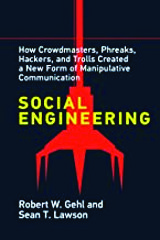 In the wake of the 2016 election, many have come to realize that we have entered an unprecedented era of manipulative communication. Con-artists, often hiding behind false personas, and acting on behalf of hidden actors, have learned to flood social media with disinformation, divisive memes, and snarky attacks aimed at election meddling and sowing social discord. Manipulative communication—advertising and propaganda—have long existed, but the affordances of social media, seem to have put manipulation on steroids. How did this mess develop and what can be done about it?
In the wake of the 2016 election, many have come to realize that we have entered an unprecedented era of manipulative communication. Con-artists, often hiding behind false personas, and acting on behalf of hidden actors, have learned to flood social media with disinformation, divisive memes, and snarky attacks aimed at election meddling and sowing social discord. Manipulative communication—advertising and propaganda—have long existed, but the affordances of social media, seem to have put manipulation on steroids. How did this mess develop and what can be done about it?
The authors of Social Engineering: How Crowdmasters, Phreaks, Hackers, and Trolls Created a New Form of Manipulative Communication attempt to answer both questions, first by giving the new form a name—masspersonal social engineering—and then by tracing its lineage.
As they tell it, masspersonal social engineering is a mashup of two earlier manipulation technologies, each developed to exploit the affordances of earlier communication technologies, first the advent of mass media—broadcast and print—and later, the expansion of the phone system.
Exploiting the newly available mass media, the early pioneers of advertising and public relations developed several now familiar manipulative techniques—publicity stunts, specious claims, fake front groups, celebrity endorsements—aimed to sway a mass audience.
Later, the widespread expansion of the telephone system saw the rise of an early tribe of hackers called Phone Phreaks. Hacking the phone system often required conning phone company employees into giving out privileged information and access. The Phreaks soon developed and honed a system of interpersonal con-artistry they proudly called “social engineering.”
Stated briefly, but fully described in the book, the techniques were trashing, pretexting, bullshitting, and penetrating. Taken together, they involved researching targets by sifting through clues they left behind, creating a false but convincing persona and reason for contact, then using a friendly mix of truth and bullshit to con the targets into doing things they would not otherwise do. While interpersonal social engineering worked, it was labor intensive, taking many attempts to achieve success.
The authors argue that social media has allowed the techniques of mass and interpersonal social engineering to meld and grow in reach and ease of use. With its vast troves of personal data, its algorithms and sorting capabilities, and its high tolerance for fake accounts, social media does much of the con-artist’s work for them, making it vastly easier to reach likely targets with the right bullshit message to influence how they believe and act.
Stepping back, the authors discuss contextual issues surrounding the use of masspersonal techniques and suggest ways to ameliorate their use by addressing their constituent elements.
Social Engineering provides an interesting and informed analyses and is well worth the read for anyone attempting to better understand the often-baffling ways in which contemporary public opinion is being shaped.
Patrick Lufkin
Patrick Lufkin is an STC Fellow with experience in computer documentation, newsletter production, and public relations. He reads widely in science, history, and current affairs, as well as on writing and editing. He chairs the Gordon Scholarship for technical communication and co-chairs the Northern California technical communication competition.
How to Take Over the World: Practical Schemes and Scientific Solutions for the Aspiring Supervillain
Ryan North. 2022. Riverhead Books. [ISBN 978-0-593-19201-6. 416 pages, including index. US$28.00 (hardcover).]
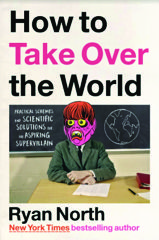 There are many “how to” books available on about every topic imaginable: cooking, gardening, painting, software use, etc. The format is so useful that a “how to” document is a technical communication staple. However, humorist Ryan North takes on the greatest challenge of this genre and documents How to Take Over the World: Practical Schemes and Scientific Solutions for the Aspiring Supervillain.
There are many “how to” books available on about every topic imaginable: cooking, gardening, painting, software use, etc. The format is so useful that a “how to” document is a technical communication staple. However, humorist Ryan North takes on the greatest challenge of this genre and documents How to Take Over the World: Practical Schemes and Scientific Solutions for the Aspiring Supervillain.
Within this handbook are hidden gems of wisdom that any aspiring evil villain would need to see their schemes come to fruition. At first, the book appears to be purely whimsical featuring topics such as where to build your evil lair and how to clone dinosaurs for your evil army to ride. Although these tropes are common in James Bond movies and comic books, what North’s book does is examine what it would take to use these plot devices in the real world. As an aspiring villain, what would it take to run a self-sufficient evil lair? Building in a volcano is too impractical while flying in an airship is not fuel efficient. After explaining research based on actual science, the lair must contain a certain number of farmable acres run by a certain number of minions to be viable, for example. Additionally, it must be located on land that is not controlled by a government, of which it turns out there are a few locations, such as Bir Tawil on the border of Egypt and Sudan. If creating your own country is not good enough, you can rule an existing one through voter fraud and creating computer viruses, both of which are explained conceptually. Throughout the book are interesting sidebars such as Wikipedia hoaxes (an imaginary Egyptian scholar named “Sheikh Urbuti” was the longest-undiscovered hoax) and informative and clever illustrations. Combined with North’s wry humor, the instructions and thoughts are written so that even a villain of the sternest disposition will crack both a smile and an aspiring hero’s head, while learn something new at the same time.
While How to Take Over the World will not really teach you how to achieve global domination, it will provide you with a humorous light science discussion of the general principals. For example, it looks like the world is not yet able to viably clone dinosaurs, but with current technology you can create a spacecraft that will transport your remains and a history of your villainous deeds millions of years through space. Do not wait to see your plans fail at the hands of do-gooders; rush to (legally) obtain How to Take Over the World so you will succeed in your machinations to exert absolute control over, at the very least, your armchair.
Timothy Esposito
Timothy Esposito is an STC Fellow, current STC Vice President, and past president of the STC Philadelphia Metro chapter. He is the Manager of Logistics Documentation at Oracle with more than 20 years of technical communication experience.
Embodied Environmental Risk in Technical Communication: Problems and Solutions Toward Social Sustainability
Samuel Stinson and Mary Le Rouge, eds. 2022. Taylor & Francis. [ISBN 978-1-0321-5549-4. 290 pages. US$44.95 (softcover).]
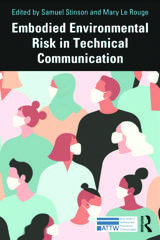 If you are a practitioner or teacher working in the field of technical communication, environmental education, science communication, or public health, the material in Embodied Environmental Risk in Technical Communication: Problems and Solutions Toward Social Sustainability will give you a valuable perspective and great food for thought. Editors Samuel Stinson and Mary Le Rouge provide a collection meant as stated on the book’s back cover, “to provide an understanding of environmental risk that promotes social justice.” The editors consider how to improve technical communication through this understanding of environmental risk while promoting social justice. They organized the collection effectively into three groups:
If you are a practitioner or teacher working in the field of technical communication, environmental education, science communication, or public health, the material in Embodied Environmental Risk in Technical Communication: Problems and Solutions Toward Social Sustainability will give you a valuable perspective and great food for thought. Editors Samuel Stinson and Mary Le Rouge provide a collection meant as stated on the book’s back cover, “to provide an understanding of environmental risk that promotes social justice.” The editors consider how to improve technical communication through this understanding of environmental risk while promoting social justice. They organized the collection effectively into three groups:
- Representations of the Human Body
- Representations of the Earth’s Body
- Representations of Human Beings and Earth Together
As a reader might expect from a risk communication book, the material in the Representations of the Human Body section deals with communication about the risks related to COVID-19 with one piece about how to communicate more effectively via email with college students on this topic.
In the Representations of the Earth’s Body section, one piece is about communication regarding the risks—such as pollution—for the Ohio River. Issues raised include which organization defines the risk, as typically it is the Environmental Protection Agency (EPA) (p. 115). We can also look at how a regulatory agency defines risk in contrast to a non-profit. We can look at an example of risk communication from the EPA’s Great Lakes Initiative in explaining issues such as the risks associated with toxic algae blooms. We can ask—which groups best define and communicate risk—is it a governmental agency such as the EPA or a local non-profit with volunteers? This is an example of the issues raised in this section of Embodied Environmental Risk in Technical Communication.
Jeanette Evans
Jeanette Evans is an STC Associate Fellow; active in the Ohio STC community, currently serving on the newsletter committee; and co-author of an Intercom column on emerging technologies in education. She holds an MS in technical communication management from Mercer University and undergraduate degree in education.
Save Me! (From Myself): The Existential Crises of a Creative Introvert
So Lazo. 2022. Chronicle Books LLC. [ISBN 978-1-7972-0341-6. 128 pages. US$14.95 (hardcover).]
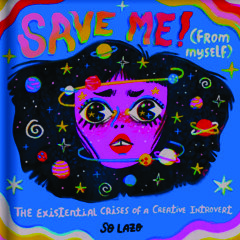 Save Me! (From Myself): The Existential Crises of a Creative Introvert by So Lazo, an author and illustrator from El Salvador, is full of the author’s signature artistic style which they describe as “a combination of magic, vibrant colors, emotions, gender identity, and cuteness” (https://www.queef.be/solazo). From cover to cover, each page offers vivid illustrations that convey relatable emotions and experiences such as imposter syndrome, unrequited love, and more.
Save Me! (From Myself): The Existential Crises of a Creative Introvert by So Lazo, an author and illustrator from El Salvador, is full of the author’s signature artistic style which they describe as “a combination of magic, vibrant colors, emotions, gender identity, and cuteness” (https://www.queef.be/solazo). From cover to cover, each page offers vivid illustrations that convey relatable emotions and experiences such as imposter syndrome, unrequited love, and more.
Lazo starts this book with a letter to the reader in which they declare, “This book is extremely personal; it’s my diary, it’s hope, it’s heartbreak, it’s revenge, it’s life, it’s raw.” The honesty and depth of these illustrations are what make this book so compelling. One of my favorite illustrations depicts the reality of social anxiety with a touch of deprecating humor, which I deeply relate to. It’s labeled “me flirting” and offers six panels in which one person—presumably “me”—notices another, stares, looks away when the other person looks at them, continues staring, then the other person leaves, and the last frame is the person’s immediate reaction of “OK, guess I’ll die alone.” Save Me! (From Myself) illustrates complex emotions and experiences. Chances are that you’ll find at least one illustration that you relate to as well.
Besides Save Me! (From Myself), Lazo has another book titled, Witch, Please: Magical Musings on Life, Love, and Owning Your Power, which is a book of illustrations that “celebrates the power and diversity of contemporary witches in this enchanting love letter to all things occult” (https://www.chroniclebooks.com/products/witch-please). If you’re a fan of Lazo’s style, you can also check out their personal brand which features clothes and other products featuring their illustrations.
Sara Buchanan
Sara Buchanan works at LCS, a property management software company, in Cincinnati, OH. In her free time, she’s an avid reader, enjoys cooking, and doting on her cats: Buffy and Spike.
The Secret Language of Maps: How to Tell Visual Stories with Data
Carissa Carter. 2022. Ten Speed Press. [ISBN 978-1-9848-5800-9. 172 pages, including index. US$14.99 (softcover).]
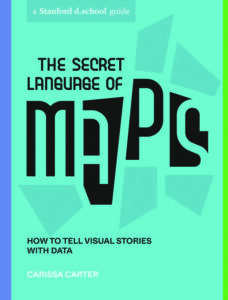 Most people have at least a limited experience with maps, whether it is from an app on their phone, a navigation system in their car, or a giant misfolded piece of paper from AAA. However, understanding the art and science that goes into creating a map is a topic which many do not stop to consider. In The Secret Language of Maps: How to Tell Visual Stories with Data, Carissa Carter attempts to explain how maps convey content in a visual manner.
Most people have at least a limited experience with maps, whether it is from an app on their phone, a navigation system in their car, or a giant misfolded piece of paper from AAA. However, understanding the art and science that goes into creating a map is a topic which many do not stop to consider. In The Secret Language of Maps: How to Tell Visual Stories with Data, Carissa Carter attempts to explain how maps convey content in a visual manner.
While you might expect a book on maps to begin with basics, such as map scale, orientation, the map legend, or the type of map, Carter uses the structure of a missing persons case to drive the explanation of maps of all types. In the context of The Secret Language of Maps, the maps are not just geographical, but illustrations of data. However, to help ease into the concept of mapping data, the first several chapters are a story of a fictional murder mystery. Once the stage is set and some illustrated clues are given to the protagonist, the book shifts into a lecture format describing the clues and how they are different forms of data maps. As the book progresses, the chapters switch between narrative and instructional, always building on one another. For example, Carter analyzes the clues in the mystery to determine what type of data they are and how they correlate with other unrelated data. Various tools are used ranging from Venn diagrams to bar charts to timelines. Consequently, the book contains illustrations, charts, colors, logic flows, a gatefold to hold the larger concepts, and of course, maps. Even the book’s mystery section appears within an illustrated manila envelope holding the case files.
If you enjoy analyzing and visualizing data and want to learn underlying concepts behind creating various data maps while solving mysteries, then The Secret Language of Maps is the book for you. Similarly, if you enjoy solving mysteries, then this book can help with your data analysis. The light style of writing, the wonderful illustrations and use of color, and the size of the book make it an appealing source to add to your book collection. However, based on the data analysis skills Carter teaches, it is not recommended that you assume a life of crime, so please refrain from creating your own true life murder mystery situations after reading this book.
Timothy Esposito
Timothy Esposito is an STC Fellow, current STC Vice President, and past president of the STC Philadelphia Metro chapter. He is the Manager of Logistics Documentation at Oracle with more than 20 years of technical communication experience.
25 Great Sentences and How They Got That Way
Geraldine Woods. 2020. W.W. Norton & Company. [ISBN 978-0-393-88237-7. 316 pages, including index. US $17.95 (softcover).]
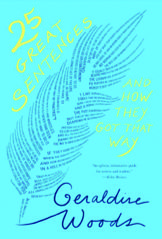 Geraldine Woods is an author of adult and children’s books, with extensive experience teaching English. Woods mentioned that she enjoyed writing 25 Great Sentences and How They Got That Way and her passion for the English language is apparent. This book is intended for people who are avid readers and have an enthusiasm for masterful writing—and an appreciation of the effort to create it.
Geraldine Woods is an author of adult and children’s books, with extensive experience teaching English. Woods mentioned that she enjoyed writing 25 Great Sentences and How They Got That Way and her passion for the English language is apparent. This book is intended for people who are avid readers and have an enthusiasm for masterful writing—and an appreciation of the effort to create it.
As the book’s title states, Woods has written twenty-five chapters where she performs an in-depth analysis of one sentence that she believes, “… exemplifies a distinct element of style” (p. xvi). She also includes additional sentences “…that illustrate the same technique or variations of it” (p. xvi). Although Woods used grammatical and rhetorical techniques in her analysis, she purposely avoids including the terms in the book, unless needed. Therefore, readers of all levels benefit from her insightful, jargon-free analysis.
Woods organized the chapters under five groupings that cover structure, diction, sound, connection/comparison, and extreme creativity, which she defines as “…sentences that stretch the limits of conventional expression…” (p. xvi).
Her comprehensive research and eclectic selection of examples is a large part of the appeal in 25 Great Sentences. Readers are treated to the familiar, such as writing that has influenced our culture (a sentence from Yoda, a popular Star Wars character on page 42) and our society (a sentence from Martin Luther King, Jr.’s “Letter from a Birmingham Jail” on page 233) to discovery of writers or artists that may be new to them.
Woods also encourages her readers to practice the techniques she analyzes via her “For the Writer” section located at the end of each chapter. The creative, well-designed exercises reflect her education background.
Lastly, 25 Great Sentences includes a helpful “Index of Authors and Sentence Sources” for people who would like to read a cited author’s complete work or explore new artists and writers.
Ann Marie Queeney
Ann Marie Queeney is an STC senior member with more than 20 years’ experience in the medical device industry. Her STC experience includes serving as a 2020-2022 Board member and Communities Affairs Committee Chair, special interest group leader, and STC Education Committee member. Ann Marie is the owner of A.M. Queeney, LLC.
Our Plastic Problem and How to Solve It
Sarah J. Morath. 2022. Cambridge University Press. [ISBN 978-1-108-79537-1. 202 pages, including index. US$24.99 (softcover).]
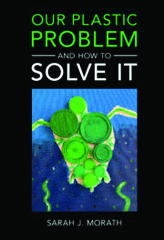 It is important to not let the book’s title mislead you into thinking you will find concrete solutions that will eliminate our global plastic problem. Instead, Our Plastic Problem and How to Solve It is a book that helps readers “understand the complexity of plastic pollution,” and the need for an interdisciplinary and “multimodal approach to solving this problem” (p. 2). In other words, the work to solve the plastic problem still needs to be done; this book, however, will help readers understand what that work involves.
It is important to not let the book’s title mislead you into thinking you will find concrete solutions that will eliminate our global plastic problem. Instead, Our Plastic Problem and How to Solve It is a book that helps readers “understand the complexity of plastic pollution,” and the need for an interdisciplinary and “multimodal approach to solving this problem” (p. 2). In other words, the work to solve the plastic problem still needs to be done; this book, however, will help readers understand what that work involves.
Morath divides the book into three sections: 1) Plastic in the Environment, which provides background information about how pervasive and detrimental this problem is; 2) Multimodal Approaches to Solving Our Plastic Problem, which details effective and ineffective federal, state, local, international, and other efforts to curb plastic pollution; and 3) Innovation and Design, which provides information on the recycling process and what it means to move toward a circular economy.
For a subject that includes complex statistics and scientific material, Morath makes the information easy to read and follow, and part of what makes the writing successful is the chapter structure. Each chapter opens with an introduction that directly states what will be covered in that chapter, why it is important to the overall conversation about plastic pollution, and what readers can expect to know by the end of the chapter. Chapter summaries are also included, which provide a thorough overview of main ideas. The writing itself is not pretentious or overly scientific; however, Morath does not shy away from explaining essential, but complex, terminology. Clear, direct definitions are always provided, so readers with little knowledge about the various subjects covered in the book will not be lost or in over their heads.
Based on the title, I admit that I expected to be told exactly what to do at all levels of society to eliminate plastic pollution and prevent further proliferation of unrecyclable plastics, but Our Plastic Problem and How to Solve It is like many other books on this subject in that it simply recounts what causes the problem, what has been done (or not done) to help clean up or curb the problem, and what still needs to be done. The book’s goal, as stated earlier, is simply to inform readers about the extent and severity of the problem. Solutions are still up in the air; however, Morath does provide helpful information that readers can consider when making consumer decisions and understand what is happening at political and legal levels when it comes to environmental matters, especially those associated with plastics. To read this book as a solo venture may not leave you feeling particularly empowered, but if this book were used in a book club or for a class that includes social advocacy, where conversation—and maybe even environmental advocacy can take place—well, there might be a more practical and personally satisfying outcome.
Diane Martinez
Diane Martinez is an STC member and an associate professor of English at Western Carolina University where she teaches technical and professional writing. She previously worked as a technical writer in engineering, an online writing instructor, and an online writing center specialist.
The Insider’s Guide to Technical Writing
Krista Van Laan. 2022. 2nd ed. XML Press [ISBN 978-1-937434-78-6. 352 pages, including index. US$35.95 (softcover).]
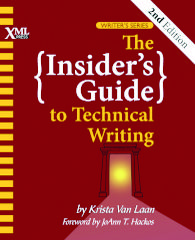 If you have been repeatedly asked, what does it take to become a technical writer or what book should someone read on the subject, you will appreciate having Krista Van Laan’s The Insider’s Guide to Technical Writing, 2nd ed. to recommend. In this new edition, JoAnn T. Hackos in the Foreword emphasizes features including: What managers expect today; what to put in a Techwriter’s Toolkit; and how technical writing can create successful users who become loyal customers.
If you have been repeatedly asked, what does it take to become a technical writer or what book should someone read on the subject, you will appreciate having Krista Van Laan’s The Insider’s Guide to Technical Writing, 2nd ed. to recommend. In this new edition, JoAnn T. Hackos in the Foreword emphasizes features including: What managers expect today; what to put in a Techwriter’s Toolkit; and how technical writing can create successful users who become loyal customers.
Have you read job ads recently? There can be long lists of technical tools that seem to be in high demand, but here are some common skills a hiring manager looks for:
Hit the Ground Running: With the fast pace of industry, one trait that all technical writers need is the ability to hit the ground running. More than just being familiar with computer software, we need to learn quickly about or already know the company’s products.
Logical Mindset: This type of person is left-brain dominant with skills in verbal analytic, abstract, and logical activities. We can think and organize clearly but may come up short in the hand-eye coordination of the right-brain subject matter expert tester or engineer.
Ability to communicate with potential users of the company’s products: Keep someone you know personally in mind when writing documentation. Early in my career, I wrote for parents who were skilled laborers in a factory. If they could understand, then I had reached my target audience. Another typical customer may be someone familiar with written documents but whose company needs to switch to digital formats.
Other important technical writing topics discussed in this second edition is:
Tool Knowledge, Chapter 12. For your convenience there is also a condensed list of tool needs on page 31. Years ago, a tech writer did not have to write for the web; it was all paper deliverables. Nowadays, you might even need to work with voice-over talent to create social media and training materials.
Agile Process, Chapter 9. This popular development process is based on across the company teamwork and open communication. Team members keep current by attending regular meetings. Before Agile, individual technical writers could be hard-pressed to know the latest developments or be prepared to meet unexpected deadlines.
Outline Skills, Chapter 15. The beginning technical writer may find this chapter the most useful. You will be able to grasp the tasks expected and the order to complete them in. The outline serves as the first draft for review by team members. An outline is also useful to group content. Feel free to incorporate existing company documentation; this is not plagiarism.
Each of us in our lifetime has been a customer who tried a new product and needed instructions to assemble or operate it properly. So, the absolute best thing about the technical communication profession for me is that anyone willing to apply themselves can make a good living as a technical communicator. Not every reporter, magazine article writer, novelist/fiction writer can truthfully claim that.
Donna Ford
Donna Ford has been an STC member and a technical writer in the hardware, software, IT, and government healthcare industries. She holds an Information Design certificate from Bentley College. Donna is an author who also reviews trade books online for the US Review of Books.
Academia Next: The Future of Higher Education
Bryan Alexander. 2020. Johns Hopkins University Press. [ISBN 987-1-4214-4326-3. 352 pages, including index. US$27.95 (softcover).]
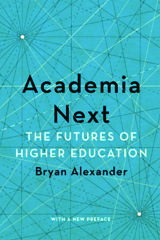 I sincerely suggest that you take an inordinately deep breath and find an agreeable chair before opening Bryan Alexander’s very deep dive into the unpredictable evolution explored in his seminal volume Academia Next: The Future of Higher Education. Quippy chapter titles not withstanding (Chapter 12: Siri, Tutor Me for example), the author pulls no punches in this epic work. The preface that drives home the challenging premise that “academia” is, like an amorphous entity, more than ever incurably entangled within the larger cultural context and all the emerging dystopia engendered therein. In his eyes, the Ivory Tower has become University Inc.
I sincerely suggest that you take an inordinately deep breath and find an agreeable chair before opening Bryan Alexander’s very deep dive into the unpredictable evolution explored in his seminal volume Academia Next: The Future of Higher Education. Quippy chapter titles not withstanding (Chapter 12: Siri, Tutor Me for example), the author pulls no punches in this epic work. The preface that drives home the challenging premise that “academia” is, like an amorphous entity, more than ever incurably entangled within the larger cultural context and all the emerging dystopia engendered therein. In his eyes, the Ivory Tower has become University Inc.
The simple fact that there are 83 pages (25% of the book) of reputable notes in the addendum should, in and of itself, be an adequate omen of the approaching gauntlet. Alexander asserts that higher education, currently in transition, is perilously ensnared with the pandemic, anti-racism activism, climate change, declining birth rates in developed nations, sexual assault, library declines, “adjunctification” loss of tenure, decline of the humanities, increased demand for grant funding and the marketable patents hopefully generated, student debt, wealth inequality, and on it goes (p. 37).
The only arenas which still hold ground amidst this capitalization of classical academia are the increase in both the number and compensation of administrators along with that antitheism to academia, sports. Universities are now, because of significant cultural changes during recent decades, businesses, and major ones at that. This is nicely summarized in the Higher Education Crisis Graph and is not a complimentary characterization (p. 21).
In the first half of Academia Next, the author deals specifically with many of the trends briefly outlined in the lengthy preface. He includes perhaps an excess of background data for many of his assertions which does lead to a tedious, albeit detailed, read.
The latter half of the volume, “Scenarios” turns a more speculative eye on the possible futures of the yet to be academia of tomorrow. While the success rate of futurists in general is rather spotty, the author is none the less diligent in his efforts to conceptualize prospective constructs that are rooted in current trends. After all, who could have predicted what the COVID-19 pandemic would do to in-class attendance levels.
I have barely touched upon the full list of related, influential forces driving today’s educational institutions, large and small, the educational caste system, entrance biases, disparities in secondary educational resources, the ascendancy of international educational markets, etc. Alexander takes issue with these and many other topics in Academia Next. It’s a dense, highly referenced volume that should be a must read for anyone involved in our educational system.
Lynne Cooke
Lynne Cooke is a Clinical Assistant Professor at Arizona State University (ASU) where she teaches courses on usability, digital media, and portfolio development. She is also an STC member of the Arizona Chapter and the ASU Internship Coordinator.
Rebel with a Clause: Tales and Tips from a Roving Grammarian
Ellen Jovin. Mariner Books. [ISBN 978-0-358-27815-3. 400 pages, including index. US$24.00 (softcover).]
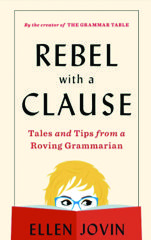 It’s not unusual to have a whimsical idea you want to put into action. For example, maybe you dream of traveling to all 50 states and collecting a postcard or a shot glass from each one. In Rebel with a Clause: Tales and Tips from a Roving Grammarian, Ellen Jovin did set out to visit all 50 states (she and her husband got to 47 of them before the pandemic hit), find spots with the best grammar traffic, and provide comfort to anyone distraught about grammar.
It’s not unusual to have a whimsical idea you want to put into action. For example, maybe you dream of traveling to all 50 states and collecting a postcard or a shot glass from each one. In Rebel with a Clause: Tales and Tips from a Roving Grammarian, Ellen Jovin did set out to visit all 50 states (she and her husband got to 47 of them before the pandemic hit), find spots with the best grammar traffic, and provide comfort to anyone distraught about grammar.
The journey started in September 2018 when Jovin—who studied 25 languages (for fun!) and taught grammar and writing for decades—carried a folding table and a descriptive sign to the northern entrance of the Seventy-Second Street subway station in New York. She soon moved on to other locations around town. Within six months, she took the Grammar Table across state lines and now we have this book that chronicles some of her adventures.
Jovin said upfront that this was not a Grammar Judgement table. Some of her visitors had experiences with people who made them feel bad about their use of language, and Jovin recognized that language is connected to a person’s sense of self and power. This especially applied to visitors who didn’t speak English natively. Conversations spanned vernaculars—Arabic, Dutch, German, Hebrew, Indonesian, Polish, Tagalog, and several others. Her visitors were diverse, but what bound everyone together was language.
Each chapter of Rebel with a Clause addresses a specific grammar topic—starting with the Oxford comma and immediately transitioning to grammar vocabulary (interjections, linking verbs, prepositional phrases, and the like). This book would feel incomplete if it didn’t address affect and effect, farther and further, and lay and lie; plus, you get to read about adverbial antics, peripatetic past participles, gerund-present participles, and texting grammar.
Jovin’s husband filmed many of the Grammar Table encounters and Jovin edited the dialogue from those recordings for clarity, length, and coherence to write this book. There are more than a few times where there seemed to be too much editing and the encounters end abruptly, but maybe you had to be there to appreciate the humor or impact of a particular situation. More importantly, the grammar questions were legitimate concerns for people to which Jovin provided answers that resolved the issues and sent people away with definitive answers.
For anyone interested in a lighthearted look at how words and punctuation are used to communicate at work, at home, among friends, and among colleagues, Rebel with a Clause is an easy read that provides insights and laughs along the way.
Michelle Gardner
Michelle Gardner is a contracted senior writer at Microsoft focused on their cloud portfolio. She has a bachelor’s degree in Journalism: Public Relations from California State University, Long Beach, and a master’s degree in Computer Resources and Information Management from Webster University.
Leading with Values: Strategies for Making Ethical Decisions in Business and Life
Neil Malhotra and Ken Shotts. 2022. Cambridge University Press. [ISBN 978-1-108-84419-1. 182 pages, including index. US$39.99 (hardcover).]
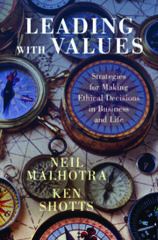 How should business leaders incorporate values in their decision making? A first step is to acknowledge that no decision, and no organization, exists outside the values of the “broader political and social environment” (p. 8). It follows that if corporations “do not exist independently of society” (p. 85), and “government doesn’t do such a great job of policy making” (p. 81), “companies have a responsibility to actively support inclusive and democratic institutions” (p. 92). A corporate leader must make decisions within a broad range of values: not only his own or those of shareholders, but also of “employees, customers, suppliers, communities” (p. 85), and “the foundational institutions of society” (p. 92).
How should business leaders incorporate values in their decision making? A first step is to acknowledge that no decision, and no organization, exists outside the values of the “broader political and social environment” (p. 8). It follows that if corporations “do not exist independently of society” (p. 85), and “government doesn’t do such a great job of policy making” (p. 81), “companies have a responsibility to actively support inclusive and democratic institutions” (p. 92). A corporate leader must make decisions within a broad range of values: not only his own or those of shareholders, but also of “employees, customers, suppliers, communities” (p. 85), and “the foundational institutions of society” (p. 92).
To achieve this goal, leaders must recognize that organizational culture primarily determines ethical behavior. As leaders, they must model that culture; “determine which policies are consistent with. . . [their own] core values” (p. 137); and “authentically communicate those values—and resultant policies—to stakeholders” (p. 137). In addition, corporate leaders must also integrate their own personal ethics within the broader organizational, socio-political, and cultural values represented by the company.
Several methods and strategies, drawn from various schools of philosophy, help leaders realize and implement their core values in ways consistent with the ethical demands of their broad constituency. These include analyses of consequentialism and utilitarianism (prioritizing the greater good over the individual); perspective-taking (applying the Golden Rule); Kant’s categorical imperative (if it’s wrong in any circumstance, it’s wrong in this circumstance); and ends versus means reasoning (using people as tools or objects to achieve goals). Underlying all is the principle of justice “ultimately grounded in strong notions of fairness” (p. 137).
Case studies include Theranos taking the “Silicon Valley culture of ‘fake it till you make it’ to an extreme” (p. 46); Steve Jobs motivating his employees with values like “Think different” while colluding with other companies “to hold down wages of engineers” (p. 2); and Juul marketing addictive e-cigarettes with flavors attractive to minors (pp. 105–107). In each case, the ends were used to justify the means. Toyota, in contrast, rehabilitated a dysfunctional General Motors plant by “managing difficult tradeoffs” (p. 7) among opposing constituencies.
No single strategy works every time, and the morality of a decision inevitably requires weighing the often-contradictory demands of stakeholders against each other. And whatever combination of ethical approaches leaders may take, they must ultimately balance their personal values against “the importance” they “place on individuals vs. overall consequences” (p. 120). Leaders may wish otherwise, but “there are no easy answers”—the buck stops with them (p. 128).
Neil Malhotra and Ken Shotts’ book, Leading With Values: Strategies for Making Ethical Decisions in Business and Life, stems from their experience teaching Stanford MBA students. Each chapter includes sections on “Takeaways,” “Suggestions for Further Reading,” and “Reflective Exercises” to stimulate further thought. In all, this book is a concise, usable, and balanced guide to making ethical decisions in business.
Donald R. Riccomini
Donald R. Riccomini is an STC member and Emeritus Senior Lecturer in English at Santa Clara University, where he specialized in engineering and technical communications. He previously spent twenty-three years in high technology as a technical writer, engineer, and manager in semiconductors, instrumentation, and server development.
Balance: How It Works and What It Means
Paul Thagard. 2022. Columbia University Press. [ISBN 978-0-231-20558-0. 336 pages, including index. US$32.00 (hardcover).]
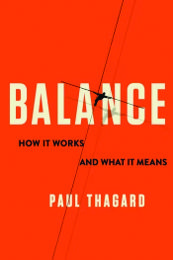 A laboratory balance is a simple, one-dimensional instrument dating back to ancient science. In its earliest form, the apparatus achieved balance with equal masses on both sides—adding mass to either side tipped it out of balance. Paul Thagard elaborates in his book Balance: How It Works and What It Means, that although the topic of balance dates to this ancient apparatus, it expands into immensely rich, multidimensional areas. In his book, the author first explains scientifically what balance is from a biological and medical perspective and then shifts into an evaluation of balance metaphors that help us fill in the gaps of our scientific knowledge—and whether these metaphors are strong, bogus, or even toxic to culture.
A laboratory balance is a simple, one-dimensional instrument dating back to ancient science. In its earliest form, the apparatus achieved balance with equal masses on both sides—adding mass to either side tipped it out of balance. Paul Thagard elaborates in his book Balance: How It Works and What It Means, that although the topic of balance dates to this ancient apparatus, it expands into immensely rich, multidimensional areas. In his book, the author first explains scientifically what balance is from a biological and medical perspective and then shifts into an evaluation of balance metaphors that help us fill in the gaps of our scientific knowledge—and whether these metaphors are strong, bogus, or even toxic to culture.
Inspired by Thagard’s own bout of vertigo, the first four chapters explain the science behind human balance and some of the common conditions that result as a breakdown of the mechanisms. He continues to use his personal experience with vertigo as an example, or the “experience of illusory motion: something seems to be moving even though it is not” (p. 42). This balance malfunction usually includes a mismatch of signals from all the neurological functions involved—the inner ear canals, vision, and hair cells send information to the brain—when vertigo occurs these signals do not match, thus creating a spinning sensation.
In the section linking balance to feelings, Thagard applies his balance mechanisms to the expanding field of mind and body, or the origins of consciousness.
“My . . . theory explains why balance is usually unconscious but enters consciousness when problems arise. Unlike (other theories) my theory also explains why different imbalance experiences such as vertigo and nausea come with different feelings” (p. 105).
In chapter 5, Balance shifts to an explanation of metaphor and its role in understanding balance. Thagard states that literal mechanisms only explain basic biological and medical applications of balance, yet it is much richer than that. “But balance concepts flourish in other areas of human thought, including science (chemical equilibrium), medicine (balanced diet), psychology (stable personality), art (balanced composition), and philosophy (reflective equilibrium)” (p. 106).
In this lengthy analysis covering many subjects regarding balance, Thagard again references vertigo. Most notably in his analysis of the film Vertigo starring James Stewart and Kim Novak. His observation, “Hitchcock largely flubbed the science of vertigo, but he powerfully portrayed the balance disorder of dizziness triggered by heights. Just as effectively, he presented metaphorical vertigo provoked by uncertainty in romantic relationships and especially by astonishing events that have no explanation” (p. 232).
In conclusion, the author’s analysis of balance in philosophy challenges the assumption that being out of balance is not entirely negative—the idea of metabalance. This implies that “leading a meaningful life requires finding a balance between balance and imbalance” (p. 269). Thagard concludes by suggesting that a satisfying life requires an element of both.
Julie Kinyoun
Julie Kinyoun is an on-call chemistry instructor at various community colleges in Southern California. An avid reader, she enjoys reviewing books that help her become a better educator.
Fragile Futures: The Uncertain Economics of Disasters, Pandemics, and Climate Change
Vito Tanzi. 2022. Cambridge University Press. [ISBN-13 978-1-009-10012-0. 246 pages, including index. US$24.99 (hardcover).]
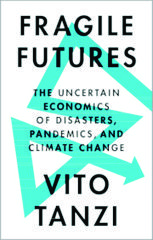 How can governments prepare for unpredictable events such as a pandemic or climate change? That is one of the questions raised by economics professor Vito Tanzi that he also addresses in Fragile Futures: The Uncertain Economics of Disasters, Pandemics, and Climate Change, which is an idea from economist John Maynard Keynes about the distinction between predictable and unpredictable events and how governments only prepare for predictable events. The author argues that governments have not in the past prepared for unpredictable events, such as a pandemic or climate change, and proposes that if there is to be human progress in a future world, governments should look at a more global government role to deal with unpredictable disasters.
How can governments prepare for unpredictable events such as a pandemic or climate change? That is one of the questions raised by economics professor Vito Tanzi that he also addresses in Fragile Futures: The Uncertain Economics of Disasters, Pandemics, and Climate Change, which is an idea from economist John Maynard Keynes about the distinction between predictable and unpredictable events and how governments only prepare for predictable events. The author argues that governments have not in the past prepared for unpredictable events, such as a pandemic or climate change, and proposes that if there is to be human progress in a future world, governments should look at a more global government role to deal with unpredictable disasters.
Tanzi mentions famine as a topic on disasters. He notes that famines can be due to poor distribution of income as some economic theories prevent income redistribution. In some cases, as in China and Russia, famines resulted from “extreme left experiments” (p. 73). Tanzi feels governments in the future should take a global approach as they work to eliminate famine.
In the climate change section, Tanzi concludes that “it may be a cruel illusion to believe that private actions, helped by some important technological changes, will, automatically and quickly, solve the ongoing global warming problem” (p. 164). He also notes it is easy to ignore climate change because it does not happen suddenly. While there is hope that spontaneous adaptation will help (p. 164), this is not enough. What is needed to address issues related to climate change and global warming would be global action and agreements through organizations such as the United Nations. What will help is a coordinated global effort getting away from the interests of individuals and specific groups (p. 165). What will help is a coordinated global effort getting away from the interests of individuals and specific groups (p. 165).
Tanzi also discusses inequality in the world. An example of inequality in the United States is how the top 1% of the wealthy saves 40% of their income; the bottom 90% saves almost none of their income; the remaining 9% (in between the top and bottom) saves about 10% (p. 212). With these kinds of savings rates, Tanzi feels that the future will not hold less inequality (p. 212). To lower this inequality and address how those who are less wealthy can suffer more than the wealthy during a disaster, Tanzi has an idealistic vision of governments that include environmentalists and altruistic individuals (p. 219). These individuals would believe “as did some major thinkers in the 1950’s (such as Einstein, Gandhi and Churchill), that we need an effective, global, institutional umbrella to guide decisions that affect the whole globe” (p. 219). Of course, only time will tell if we as human beings can implement such an idea and global approach. Tanzi’s hope is that a global governmental role would help keep undesirable economic inequalities lower, as well as helping the world deal with unpredictable disasters, pandemics, and climate change.
Jeanette Evans
Jeanette Evans is an STC Associate Fellow; active in the Ohio STC community, currently serving on the newsletter committee; and co-author of an Intercom column on emerging technologies in education. She holds an MS in technical communication management from Mercer University and undergraduate degree in education.

